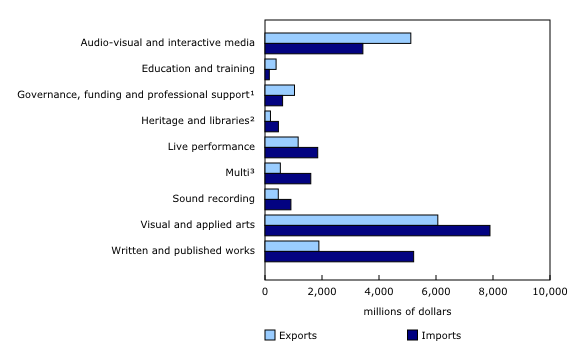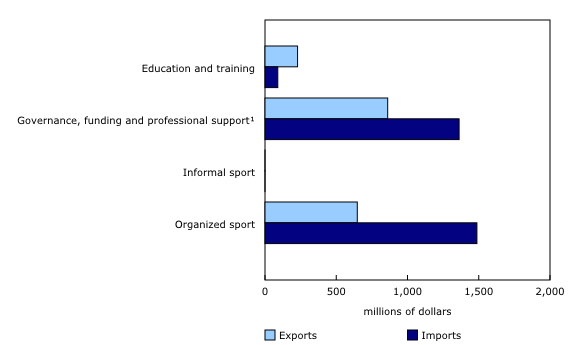Trade of culture and sport products, 2018
Archived Content
Information identified as archived is provided for reference, research or recordkeeping purposes. It is not subject to the Government of Canada Web Standards and has not been altered or updated since it was archived. Please "contact us" to request a format other than those available.
Released: 2020-10-22
In 2018, exports of culture (such as arts, films and music) and sport products increased 7.1% to $18.6 billion, outpacing imports which rose 4.2% to $25.1 billion. Culture and sport exports represented 2.6% of Canada's total exports, while culture and sport imports accounted for 3.3% of Canada's total imports.
Culture trade dominated by crafts, film and video, and books
Nearly half of all international trade of culture products in 2018 could be accounted for by crafts, film and video, and books. Together, they made up 53.8% of exports and 43.6% of imports.
Canada exported $16.9 billion of culture products in 2018, up 7.3% from the previous year. This increase was led by film and video products (+13.0%) and crafts (+7.9%). Canada's growing film sector contributed increased exports such as movie and television production, and post-production and editing services. British Columbia represented almost half of Canada's $4.2 billion in exports of film and video products. Crafts—primarily jewellery and silverware—also amounted to $4.2 billion in culture exports.
Culture imports rose in 2018 as well, as Canadians imported 4.4% more culture products, totalling $22.2 billion. Similar to exports, the imports of crafts (+7.9%) and film and video products (+10.7%) accounted for a large portion of total culture imports. Contrary to exports, the trade of books (+3.6%) also played a significant role in total culture imports, accounting for $2.4 billion in trade.
Culture products accounted for 2.4% of all goods and services exports, and 2.9% of total imports.
Impacts of COVID-19
Although not covered within the time period of this report, the COVID-19 pandemic sharply curtailed the trade of culture and sport goods and services in 2020. Border closures and cancellations of culture and sport events by most countries resulted in sharp declines in exports and imports of these products.
The data from the 2018 and the 2019 releases will constitute the baseline for comparing 2020 results and assessing the impact of the pandemic on the culture and sport sectors.
Imports of sport products nearly double that of exports
Canada exported $1.7 billion of sport products, and imported $2.9 billion in 2018. Sport products accounted for 0.2% of all Canadian exports, and 0.4% of all goods and services imports. For both imports and exports, amusement and recreation services was the major product of trade. Trade of these services includes Canadians purchasing classes at fitness and recreational centres abroad (sport imports) and international travellers going skiing in Canada (sport exports).
United States and European Union remain top trading partners
The United States was the largest source of culture and sport trade, representing 60.1% of exports and 63.4% of imports, in 2018. The European Union ranked second, accounting for 11.5% of exports and 10.6% of imports.
However, these two trading partners have seen their share of international trade with Canada slightly decline. From 2010 to 2018, the United States and the European Union have gone from representing 76.2% of total culture and sport trade, to 72.9%. However, this change is mainly a result of increased trade with other trading partners like China, as Canada has nearly tripled its overall trade to $2.4 billion from 2010 to 2018.
Broadcasting the top contributor to interprovincial trade in 2016
In 2016, interprovincial and territorial trade in culture products amounted to $17.4 billion, accounting for 4.7% of total interprovincial trade. The largest contributor continued to be broadcasting, totalling $4.3 billion. Although from 2010 to 2016, film and video and interactive media have had higher growth rates, accounting for a progressively larger share.
Interprovincial trade of sport products totalled $1.3 billion or 0.4% of total interprovincial trade in 2016. Governance, funding and professional support (which includes public sport facilities and rentals) and organized sport led total interprovincial trade of sport products.
Note to readers
The Trade of Culture and Sport Products (TCSP) provides measures of the international and interprovincial trade of goods and services attributed to both culture and sport (inclusive of the arts and heritage).
These data were developed as an extension of the Canadian Culture Satellite Account (CSA) and the Provincial and Territorial Culture Satellite Indicators (PTCI) by providing additional information about the state of culture and sport for Canada, the provinces and territories.
The TCSP have been updated to better reflect the new 2016 CSA benchmark. These revisions serve to improve the reliability and accuracy of the TCSP time series estimates. For more information on the impact of a new CSA, please refer to the CSA web page.
The TCSP is a joint initiative of Statistics Canada, other federal agencies, all provincial and territorial governments, and non-governmental organizations.
All estimates of international trade are recorded or converted to Canadian dollars using daily or monthly average exchange rates.
Culture products are goods and services produced from creative artistic activity or from the preservation of heritage.
Sport products includes goods and services related to recreational sports and physical activities, and professional, semi-professional and amateur sport clubs and independent athletes that are primarily engaged in presenting sporting events before an audience. The classification excludes goods and services that are inputs for producing sport products such as equipment, but it includes merchandise sold at sporting events.
Due to data availability, interprovincial trade can only be derived up until 2016.
Crafts
The Crafts sub-domain includes various manufactured products that originate from creative artistic activities. It includes items such as jewelry, pottery, and knives. However, due to measurement limitations estimates of trade for the Crafts sub-domain may be overstated.
Film and video
The Film and video sub-domain has undergone major enhancements starting with reference year 2015. The sources and methods for estimating this sub-domain, including the Film, Television and Video Production Industry Survey, have been revised to incorporate improved estimation methods. The new methodology increases the use of administrative data in combination with survey data to build the estimates. These improvements were applied to all economic variables, including trade.
As a result, estimates for the Film and video sub-domain for 2015 onward should not be compared with historical estimates.
Users should exercise caution when using aggregate estimates that include the Film and video sub-domain such as estimates of the Audio-visual and interactive media domain and the total aggregate for culture. These aggregates will reflect the improvements to the methodology and, depending on the economic importance of the Film and video sub-domain, could be significantly impacted by the refinements.
Digital culture products
Technological advancements in recent years have improved the efficiency of delivery methods and consumption of services. However, this has created challenges in measuring international trade of digital services. This includes digital culture products, such as online streaming services, subscriptions, and downloads that are purchased by Canadian households directly from foreign suppliers.
Products
The Economic accounts statistics portal, accessible from the Subjects module of our website, features an up-to-date portrait of national and provincial economies and their structure.
The Latest Developments in the Canadian Economic Accounts (13-605-X) is available.
The User Guide: Canadian System of Macroeconomic Accounts (13-606-G) is available.
The Methodological Guide: Canadian System of Macroeconomic Accounts (13-607-X) is available.
Contact information
For more information, or to enquire about the concepts, methods or data quality of this release, contact us (toll-free 1-800-263-1136; 514-283-8300; STATCAN.infostats-infostats.STATCAN@canada.ca) or Media Relations (613-951-4636; STATCAN.mediahotline-ligneinfomedias.STATCAN@canada.ca).
- Date modified:





